You Zhang
Medical Artificial Intelligence and Automation
How Does Instrumental Music Help SingFake Detection?
Sep 18, 2025Abstract:Although many models exist to detect singing voice deepfakes (SingFake), how these models operate, particularly with instrumental accompaniment, is unclear. We investigate how instrumental music affects SingFake detection from two perspectives. To investigate the behavioral effect, we test different backbones, unpaired instrumental tracks, and frequency subbands. To analyze the representational effect, we probe how fine-tuning alters encoders' speech and music capabilities. Our results show that instrumental accompaniment acts mainly as data augmentation rather than providing intrinsic cues (e.g., rhythm or harmony). Furthermore, fine-tuning increases reliance on shallow speaker features while reducing sensitivity to content, paralinguistic, and semantic information. These insights clarify how models exploit vocal versus instrumental cues and can inform the design of more interpretable and robust SingFake detection systems.
Segment Anything for Video: A Comprehensive Review of Video Object Segmentation and Tracking from Past to Future
Jul 30, 2025Abstract:Video Object Segmentation and Tracking (VOST) presents a complex yet critical challenge in computer vision, requiring robust integration of segmentation and tracking across temporally dynamic frames. Traditional methods have struggled with domain generalization, temporal consistency, and computational efficiency. The emergence of foundation models like the Segment Anything Model (SAM) and its successor, SAM2, has introduced a paradigm shift, enabling prompt-driven segmentation with strong generalization capabilities. Building upon these advances, this survey provides a comprehensive review of SAM/SAM2-based methods for VOST, structured along three temporal dimensions: past, present, and future. We examine strategies for retaining and updating historical information (past), approaches for extracting and optimizing discriminative features from the current frame (present), and motion prediction and trajectory estimation mechanisms for anticipating object dynamics in subsequent frames (future). In doing so, we highlight the evolution from early memory-based architectures to the streaming memory and real-time segmentation capabilities of SAM2. We also discuss recent innovations such as motion-aware memory selection and trajectory-guided prompting, which aim to enhance both accuracy and efficiency. Finally, we identify remaining challenges including memory redundancy, error accumulation, and prompt inefficiency, and suggest promising directions for future research. This survey offers a timely and structured overview of the field, aiming to guide researchers and practitioners in advancing the state of VOST through the lens of foundation models.
Towards Perception-Informed Latent HRTF Representations
Jul 03, 2025Abstract:Personalized head-related transfer functions (HRTFs) are essential for ensuring a realistic auditory experience over headphones, because they take into account individual anatomical differences that affect listening. Most machine learning approaches to HRTF personalization rely on a learned low-dimensional latent space to generate or select custom HRTFs for a listener. However, these latent representations are typically learned in a manner that optimizes for spectral reconstruction but not for perceptual compatibility, meaning they may not necessarily align with perceptual distance. In this work, we first study whether traditionally learned HRTF representations are well correlated with perceptual relations using auditory-based objective perceptual metrics; we then propose a method for explicitly embedding HRTFs into a perception-informed latent space, leveraging a metric-based loss function and supervision via Metric Multidimensional Scaling (MMDS). Finally, we demonstrate the applicability of these learned representations to the task of HRTF personalization. We suggest that our method has the potential to render personalized spatial audio, leading to an improved listening experience.
SAM-aware Test-time Adaptation for Universal Medical Image Segmentation
Jun 05, 2025Abstract:Universal medical image segmentation using the Segment Anything Model (SAM) remains challenging due to its limited adaptability to medical domains. Existing adaptations, such as MedSAM, enhance SAM's performance in medical imaging but at the cost of reduced generalization to unseen data. Therefore, in this paper, we propose SAM-aware Test-Time Adaptation (SAM-TTA), a fundamentally different pipeline that preserves the generalization of SAM while improving its segmentation performance in medical imaging via a test-time framework. SAM-TTA tackles two key challenges: (1) input-level discrepancies caused by differences in image acquisition between natural and medical images and (2) semantic-level discrepancies due to fundamental differences in object definition between natural and medical domains (e.g., clear boundaries vs. ambiguous structures). Specifically, our SAM-TTA framework comprises (1) Self-adaptive Bezier Curve-based Transformation (SBCT), which adaptively converts single-channel medical images into three-channel SAM-compatible inputs while maintaining structural integrity, to mitigate the input gap between medical and natural images, and (2) Dual-scale Uncertainty-driven Mean Teacher adaptation (DUMT), which employs consistency learning to align SAM's internal representations to medical semantics, enabling efficient adaptation without auxiliary supervision or expensive retraining. Extensive experiments on five public datasets demonstrate that our SAM-TTA outperforms existing TTA approaches and even surpasses fully fine-tuned models such as MedSAM in certain scenarios, establishing a new paradigm for universal medical image segmentation. Code can be found at https://github.com/JianghaoWu/SAM-TTA.
Time-resolved dynamic CBCT reconstruction using prior-model-free spatiotemporal Gaussian representation (PMF-STGR)
Mar 28, 2025Abstract:Time-resolved CBCT imaging, which reconstructs a dynamic sequence of CBCTs reflecting intra-scan motion (one CBCT per x-ray projection without phase sorting or binning), is highly desired for regular and irregular motion characterization, patient setup, and motion-adapted radiotherapy. Representing patient anatomy and associated motion fields as 3D Gaussians, we developed a Gaussian representation-based framework (PMF-STGR) for fast and accurate dynamic CBCT reconstruction. PMF-STGR comprises three major components: a dense set of 3D Gaussians to reconstruct a reference-frame CBCT for the dynamic sequence; another 3D Gaussian set to capture three-level, coarse-to-fine motion-basis-components (MBCs) to model the intra-scan motion; and a CNN-based motion encoder to solve projection-specific temporal coefficients for the MBCs. Scaled by the temporal coefficients, the learned MBCs will combine into deformation vector fields to deform the reference CBCT into projection-specific, time-resolved CBCTs to capture the dynamic motion. Due to the strong representation power of 3D Gaussians, PMF-STGR can reconstruct dynamic CBCTs in a 'one-shot' training fashion from a standard 3D CBCT scan, without using any prior anatomical or motion model. We evaluated PMF-STGR using XCAT phantom simulations and real patient scans. Metrics including the image relative error, structural-similarity-index-measure, tumor center-of-mass-error, and landmark localization error were used to evaluate the accuracy of solved dynamic CBCTs and motion. PMF-STGR shows clear advantages over a state-of-the-art, INR-based approach, PMF-STINR. Compared with PMF-STINR, PMF-STGR reduces reconstruction time by 50% while reconstructing less blurred images with better motion accuracy. With improved efficiency and accuracy, PMF-STGR enhances the applicability of dynamic CBCT imaging for potential clinical translation.
Multi-Attribute Multi-Grained Adaptation of Pre-Trained Language Models for Text Understanding from Bayesian Perspective
Mar 08, 2025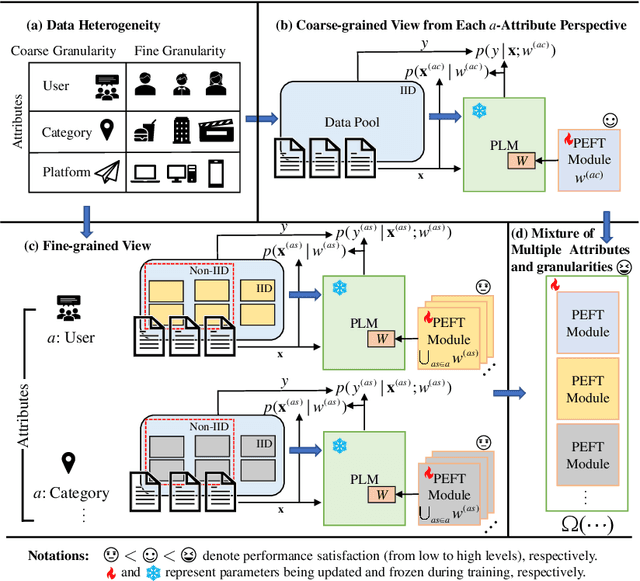
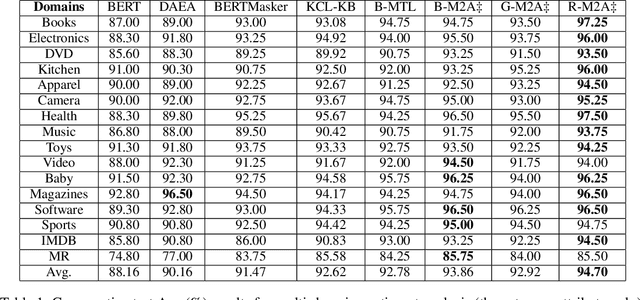
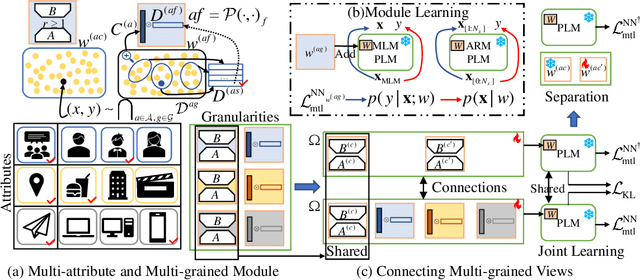
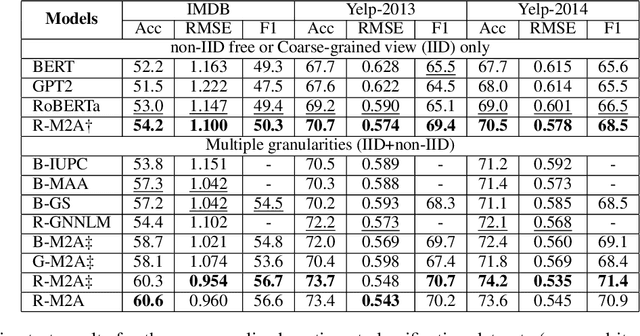
Abstract:Current neural networks often employ multi-domain-learning or attribute-injecting mechanisms to incorporate non-independent and identically distributed (non-IID) information for text understanding tasks by capturing individual characteristics and the relationships among samples. However, the extent of the impact of non-IID information and how these methods affect pre-trained language models (PLMs) remains unclear. This study revisits the assumption that non-IID information enhances PLMs to achieve performance improvements from a Bayesian perspective, which unearths and integrates non-IID and IID features. Furthermore, we proposed a multi-attribute multi-grained framework for PLM adaptations (M2A), which combines multi-attribute and multi-grained views to mitigate uncertainty in a lightweight manner. We evaluate M2A through prevalent text-understanding datasets and demonstrate its superior performance, mainly when data are implicitly non-IID, and PLMs scale larger.
Audio Visual Segmentation Through Text Embeddings
Feb 22, 2025Abstract:The goal of Audio-Visual Segmentation (AVS) is to localize and segment the sounding source objects from the video frames. Researchers working on AVS suffer from limited datasets because hand-crafted annotation is expensive. Recent works attempt to overcome the challenge of limited data by leveraging the segmentation foundation model, SAM, prompting it with audio to enhance its ability to segment sounding source objects. While this approach alleviates the model's burden on understanding visual modality by utilizing pre-trained knowledge of SAM, it does not address the fundamental challenge of the limited dataset for learning audio-visual relationships. To address these limitations, we propose \textbf{AV2T-SAM}, a novel framework that bridges audio features with the text embedding space of pre-trained text-prompted SAM. Our method leverages multimodal correspondence learned from rich text-image paired datasets to enhance audio-visual alignment. Furthermore, we introduce a novel feature, $\mathbf{\textit{\textbf{f}}_{CLIP} \odot \textit{\textbf{f}}_{CLAP}}$, which emphasizes shared semantics of audio and visual modalities while filtering irrelevant noise. Experiments on the AVSBench dataset demonstrate state-of-the-art performance on both datasets of AVSBench. Our approach outperforms existing methods by effectively utilizing pretrained segmentation models and cross-modal semantic alignment.
ASVspoof 5: Design, Collection and Validation of Resources for Spoofing, Deepfake, and Adversarial Attack Detection Using Crowdsourced Speech
Feb 13, 2025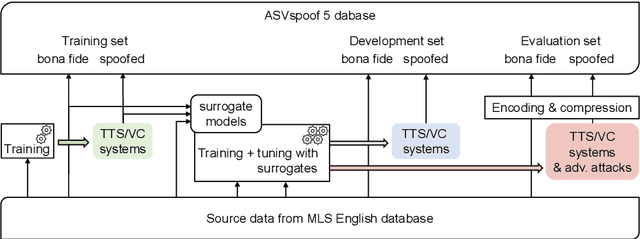

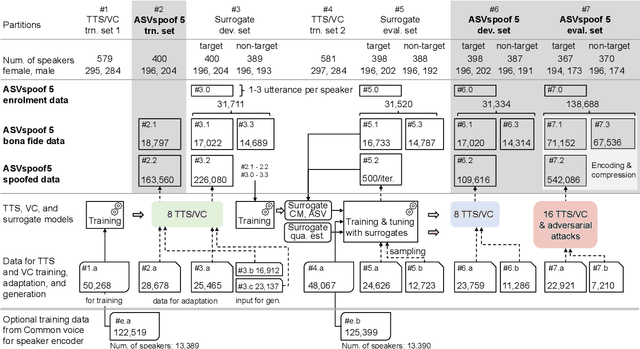
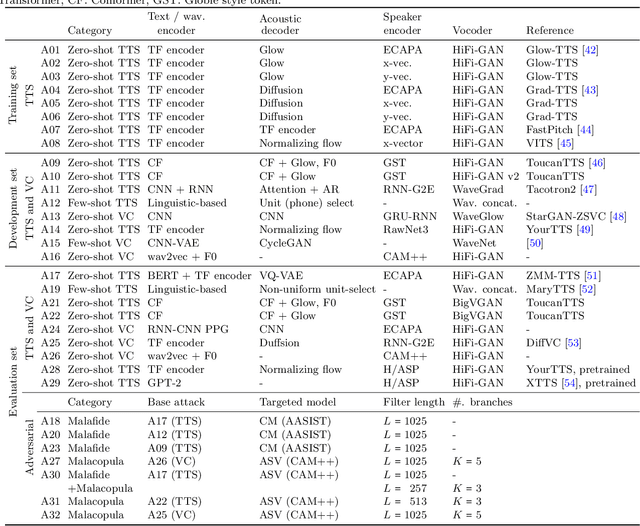
Abstract:ASVspoof 5 is the fifth edition in a series of challenges which promote the study of speech spoofing and deepfake attacks as well as the design of detection solutions. We introduce the ASVspoof 5 database which is generated in crowdsourced fashion from data collected in diverse acoustic conditions (cf. studio-quality data for earlier ASVspoof databases) and from ~2,000 speakers (cf. ~100 earlier). The database contains attacks generated with 32 different algorithms, also crowdsourced, and optimised to varying degrees using new surrogate detection models. Among them are attacks generated with a mix of legacy and contemporary text-to-speech synthesis and voice conversion models, in addition to adversarial attacks which are incorporated for the first time. ASVspoof 5 protocols comprise seven speaker-disjoint partitions. They include two distinct partitions for the training of different sets of attack models, two more for the development and evaluation of surrogate detection models, and then three additional partitions which comprise the ASVspoof 5 training, development and evaluation sets. An auxiliary set of data collected from an additional 30k speakers can also be used to train speaker encoders for the implementation of attack algorithms. Also described herein is an experimental validation of the new ASVspoof 5 database using a set of automatic speaker verification and spoof/deepfake baseline detectors. With the exception of protocols and tools for the generation of spoofed/deepfake speech, the resources described in this paper, already used by participants of the ASVspoof 5 challenge in 2024, are now all freely available to the community.
VERSA: A Versatile Evaluation Toolkit for Speech, Audio, and Music
Dec 23, 2024Abstract:In this work, we introduce VERSA, a unified and standardized evaluation toolkit designed for various speech, audio, and music signals. The toolkit features a Pythonic interface with flexible configuration and dependency control, making it user-friendly and efficient. With full installation, VERSA offers 63 metrics with 711 metric variations based on different configurations. These metrics encompass evaluations utilizing diverse external resources, including matching and non-matching reference audio, text transcriptions, and text captions. As a lightweight yet comprehensive toolkit, VERSA is versatile to support the evaluation of a wide range of downstream scenarios. To demonstrate its capabilities, this work highlights example use cases for VERSA, including audio coding, speech synthesis, speech enhancement, singing synthesis, and music generation. The toolkit is available at https://github.com/shinjiwlab/versa.
A SAM-guided and Match-based Semi-Supervised Segmentation Framework for Medical Imaging
Nov 25, 2024


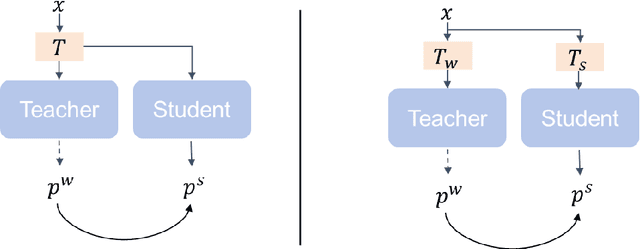
Abstract:This study introduces SAMatch, a SAM-guided Match-based framework for semi-supervised medical image segmentation, aimed at improving pseudo label quality in data-scarce scenarios. While Match-based frameworks are effective, they struggle with low-quality pseudo labels due to the absence of ground truth. SAM, pre-trained on a large dataset, generalizes well across diverse tasks and assists in generating high-confidence prompts, which are then used to refine pseudo labels via fine-tuned SAM. SAMatch is trained end-to-end, allowing for dynamic interaction between the models. Experiments on the ACDC cardiac MRI, BUSI breast ultrasound, and MRLiver datasets show SAMatch achieving state-of-the-art results, with Dice scores of 89.36%, 77.76%, and 80.04%, respectively, using minimal labeled data. SAMatch effectively addresses challenges in semi-supervised segmentation, offering a powerful tool for segmentation in data-limited environments. Code and data are available at https://github.com/apple1986/SAMatch.
 Add to Chrome
Add to Chrome Add to Firefox
Add to Firefox Add to Edge
Add to Edge